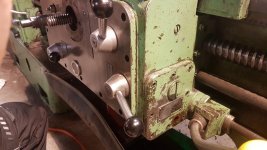Hello,
I am having a hard time setting up the whole clutch- (Ortlinghaus), brakeband-, and lever-mechanics.
It's a 1962 Martin DLZ 502 industrial lathe which I got about three weeks ago. I noticed that there was no oil in it and I am pretty sure, the seller has been using it dry. I can't make out any damaged parts though and it has been running nicely after I gave her some new oil. I wanted to use the first filling mainly for flushing. I had a lot of iso vg 150 oil so I used it for that purpose. It's way too viscous, I know.
Today I drained it and put in some iso vg 32.
The two levers for forward, neutral and reverse were quite loose and the left/main lever had a broken spring, which I replaced. Since then, they snap to neutral quite crisply. But I noticed that the brake doesn't really work too good.
The nut for adjusting the brakeband is quite sensitive and if I turn it one mm too much, I can't engage forward anymore. Reverse works most of the time even then. And: When I use the lever at the apron to put it in reverse, it touches the feed shaft.
On the backside of the machine there is no play in the lever/clutch mechanism.
I don't know how to set up the braking mechanism or what the correct procedure looks like. Same goes for the clutch.
Also I noticed that the machine runs way faster in reverse than forward... Feel like that's a really odd thing
Maybe you folks have some pointers for me. I don't want to ruin my clutch or cause any other harm.
Many thanks





I am having a hard time setting up the whole clutch- (Ortlinghaus), brakeband-, and lever-mechanics.
It's a 1962 Martin DLZ 502 industrial lathe which I got about three weeks ago. I noticed that there was no oil in it and I am pretty sure, the seller has been using it dry. I can't make out any damaged parts though and it has been running nicely after I gave her some new oil. I wanted to use the first filling mainly for flushing. I had a lot of iso vg 150 oil so I used it for that purpose. It's way too viscous, I know.
Today I drained it and put in some iso vg 32.
The two levers for forward, neutral and reverse were quite loose and the left/main lever had a broken spring, which I replaced. Since then, they snap to neutral quite crisply. But I noticed that the brake doesn't really work too good.
The nut for adjusting the brakeband is quite sensitive and if I turn it one mm too much, I can't engage forward anymore. Reverse works most of the time even then. And: When I use the lever at the apron to put it in reverse, it touches the feed shaft.
On the backside of the machine there is no play in the lever/clutch mechanism.
I don't know how to set up the braking mechanism or what the correct procedure looks like. Same goes for the clutch.
Also I noticed that the machine runs way faster in reverse than forward... Feel like that's a really odd thing

Maybe you folks have some pointers for me. I don't want to ruin my clutch or cause any other harm.
Many thanks








